In the years following World War II, Americans celebrated the end of a global war and a recovery from a previous decade of economic crisis by producing an astounding number of children, with consequences that are still unrolling to this day. It was a veritable explosion in birthrates—someone should invent a snappy term for it. Maybe the Big Bang Theory?
This focus on children was reflected in the American science fiction of the day. Many post-war SF tales used the challenges of parenthood to illuminate the anxieties of the era.1 These five works can serve as examples.
“That Only a Mother” by Judith Merril (1948)
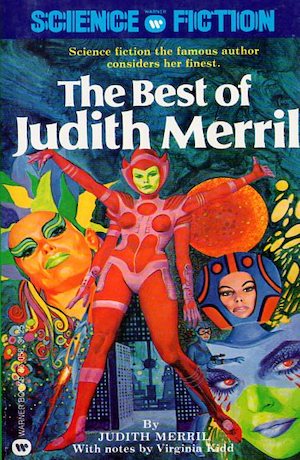
Contrary to the alarmist predictions of the nattering nabobs of negativity, long-running atomic war has proved entirely sustainable. Years after the nuclear exchanges began, civilization prevails! Every citizen does their bit for the war effort, whether, like Margaret’s husband Hank, designing atomic weapons or, like Margaret herself, producing the next generation of little warriors.
Pregnancy and motherhood are stressful at the best of times. Fallout, Hank’s possible exposure to nuclear materials, and alarming news articles about mutated babies and the subsequent horrified infanticide add even more stress. However, Margaret need not have feared. As she explains in her letters to Hank, their child is bright, precocious, and utterly adorable. How wonderful will be the day when Hank finally returns home to see his child!
An interesting fact provided in passing: the parents committing infanticide appear to be the fathers, not the mothers. Perhaps the message is that mothers can be blinded by maternal instinct. Perhaps it’s simply that Merril felt that men are more likely to be homicidally judgmental.
***
“The Veldt” by Ray Bradbury (1950)
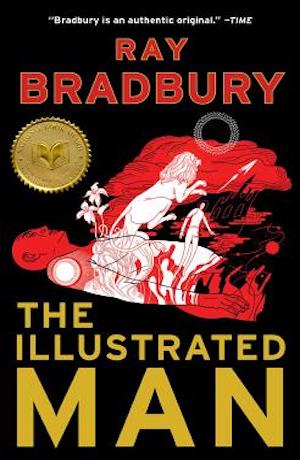
Unlike Merril’s vision of the future, the America that Bradbury’s Hadley family calls home is a peaceful, prosperous nation.2 The parents use their impressive incomes to provide their children with the best of all possible childhoods in a fully automated Happylife Home.
Primitive Americans might have settled for plunking their kids down in front of ten-inch black-and-white TV sets showing Howdy Doody. Happylife Houses offer what we would probably call virtual reality suites. Every setting the children could possibly desire is available. The realism of the settings is astounding. Mr. and Mrs. Hadley are duly astounded…albeit very briefly.
There is, as far as I know, no direct connection between Bradbury and Star Trek, but one can very easily envision the designers of the Happytime House going on to create Trek’s Holodeck suites, right down to prioritizing verisimilitude over safety.3
***
The Chrysalids by John Wyndham (1955)
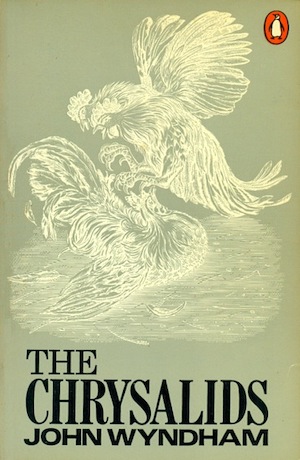
Labrador was spared the direct effects of the Tribulation that swept the sinful Old People from the face of the Earth. Indirect effects are another matter. The community of Waknuk is plagued by mutants—plant, animal, and human. Convinced that mutant offspring are an affront to God’s perfect designs, Waknuk’s pious inhabitants slaughter mutant plants and animals. They sterilize and exile mutant humans.
Six-toed Sophie’s parents did their best to conceal her sinful mutation, but in the end, she was exposed and punished for her genetic transgression. Her punishment greatly concerns her friend David Strorm. Not only is it unjust, it brings home to David just how much peril he faces. What will Waknuk’s adults do when they discover they have given birth to an entire generation of telepathic mutants. How long can David and his friends conceal their superhuman abilities?
A detail that may astound modern readers—it certainly did me when I reread the novel—is that the moral of the book turns out not to be the “can’t we all get along?” that it appears to be for much of the story, but rather, that genocide is acceptable, indeed inevitable, provided only that the right people commit it. People who like to kid themselves that genocide became socially unacceptable after the Holocaust will no doubt be much happier not knowing how many post-WWII SF works proposed solving social issues with eugenically targeted mass murder.4
***
The Fourth “R” by George O. Smith (1959)
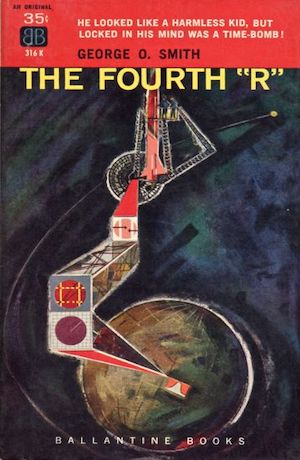
James Quincy Holden’s parents were prudent and had made their wills. When they die in an automobile wreck, Paul Brennan becomes James’ guardian. But there’s a problem: Paul Brennan arranged their deaths. James is valuable to Paul only to the extent that his continued life can help Paul gain control not only of the estate, but of their invention: the Holden Electromechanical Educator. Once Paul has control, James will be surplus to requirements.
James is well aware that Paul is his enemy. In theory, he has the intellect and education (thanks to his parents’ invention) to hold his own. But there’s a catch: James is only five years old. He may be precocious, but there’s no way that he can legally challenge Paul’s control. Is there another way?
***
Children of the Atom by Wilmar H. Shiras (1953)
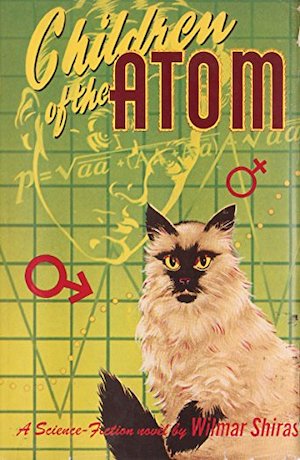
The victims of the 1958 atomic plant catastrophic were doomed by radiation. For some it was a lingering death, one that lasted long enough that they had children. The children were remarkable, as child psychologist Peter Welles discovers. Not only is his fourteen-year-old patient Tim far brighter and more capable than an average student—he and his cohort are superhuman mutants. They are the children of the atom!
Although no match for Tim’s raw intellect, Peter has an adult’s perspective and an adult’s resources. He agrees that Tim’s efforts to pass as merely average are sensible. Mundane society could be cruel were it to learn of the mutants living among them. Peter wants to help. He establishes what one might call a School for Gifted Youngsters, an establishment offering education and safety to young mutant-kind. This well-meaning effort leaves unanswered important questions, not least of which is “what is to be done about human-mutant relations in the long term?”
Those expecting some sort of mutant-human showdown may be disappointed to learn that unlike The Chrysalids, this work does not take as its core assumption that conflict between humans and mutant-kind is inevitable. This fix-up work answers the question “What if the X‑Men had been written by Zenna Henderson?” Welles is no Xavier, enlisting child soldiers. There is no analog to Magneto; the point is coexistence, not exterminationist conflict.
***
No doubt you have your own favourite works about science fictional children, overlooked works that should be noted. Comments are below.
In the words of Wikipedia editor TexasAndroid, prolific book reviewer and perennial Darwin Award nominee James Davis Nicoll is of “questionable notability.” His work has appeared in Publishers Weekly and Romantic Times as well as on his own websites, James Nicoll Reviews and the Aurora finalist Young People Read Old SFF (where he is assisted by editor Karen Lofstrom and web person Adrienne L. Travis). He is a four-time finalist for the Best Fan Writer Hugo Award and is surprisingly flammable.
[1]Readers may wonder whether anxiety about children evolved into anxiety about teens and then into anxiety about college students as the cohort of post-war kids aged. Yes, yes it did: http://www.isfdb.org/wiki/images/1/12/KAMPUS1977.jpg
[2]The Happylife House resembles the McClellan home in Bradbury’s 1950 “There Will Come Soft Rains.” If these similarities are not merely an author reusing stock elements, but rather an indication that “The Veldt” and “There Will Come Soft Rains” are in the same continuity, then it might be more accurate to say nuclear war was only deferred until such time as it could be carried out far more effectively than in Merril’s “That Only a Mother.”
[3]Star Trek: The Next Generation’s holodeck was *inexplicably* buggy. We can give Bradbury a pass for imagining buggy products, because that was the norm for his time. Why, I can still remember my childhood chemistry kits, which included radioactive materials, not to mention substances which when properly combined produced delightfully energetic reactions. Kids these days may be safer in theory, but nothing teaches one not to try to stamp out burning thermite quite like real-life experience.
[4]For that matter, such persons need to avoid noticing how many genocides there have been since 1945.










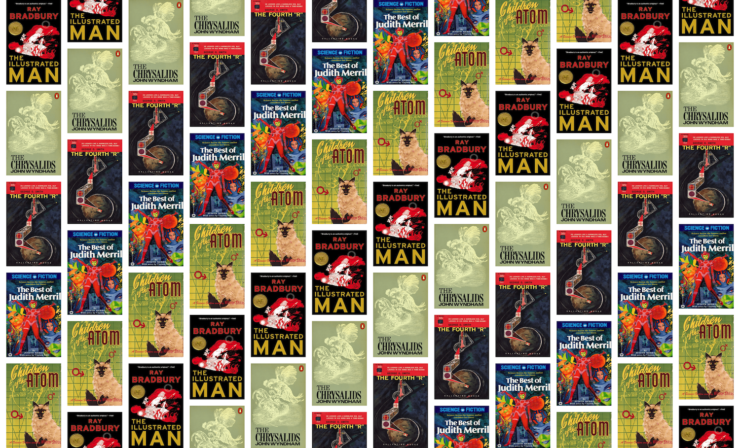
Well, Zenna Henderson has already been mentioned. And an argument could be made that dear little Anthony of Bixby’s “It’s a Good Life!” is one of the children of the future. Thank god there’s only one of him.
A book that terrified me as a young adult (I was 13 or 14 when I read it) was Louise Lawrence’s Children of the Dust. It follows three generations of children past nuclear war, from the immediate aftermath (the scene of the girl taking one last look at the sunny spring day and blue sky before closing the door on the outside forever has stayed with me) to the discovery of mutations allowing some to live in the irradiated outside.
There’s also H.M. Hoover, whose middle-grade/YA novels specialized in future children in rough situations. Amy and Axel in their decaying underground city in This Time of Darkness, orphaned Tia and Rabbit in a post-apocalyptic landscape in Children of Morrow and Treasures of Morrow, teenage Gareth living her best life in a lost colony on a dangerous planet in Another Heaven, Another Earth…
“Star, Bright”, “Mimsy Were The Borogoves” and Childhood’s End all suggest that problems with raising exceptional children will be relatively brief. For that matter, the problem is brief in “When the Bough Breaks” for somewhat different reasons.
“The Small Assassian,” by Ray Bradbury, haunted me for years. It’s about a mother who is afraid of her newborn baby, because he hates and wants to kill her. Her doctor thinks she’s just suffering from post-partum depression, but then she turns up dead.
John Brunner’s 1988 novel ‘Children of the Thunder’ is about a man whose prolific early life career as a sperm donor ends up resulting in him meeting up with a diverse collection of his progeny later in life. It is an extremely misanthropic work and is very unpleasant to read; I particularly hated the ending and cannot recommend it to anybody. (I otherwise generally like Brunner’s books.)
Re “The Veldt” and footnote #3, I personally never thought that the VR program in the HappyLife House was “buggy.” Rather, the way I read it was that the children (especially the son) were so much more intelligent than the parents that they were able to re-wire the room. Thus, the images in the room become tactile rather than just visual, auditory, and olfactory. In the story, the room doesn’t get “stuck” on the lions in Africa until after the children are denied a trip they wanted and the lions don’t become murderous until the father starts turning the house off. To me that made the story scarier; the children were prepared to committ patricide and matricide if their parents deprived them of any type of pleasure/gratification.
The Bradbury story, and some of the others in this article, remind me of Henry Kuttner and C. L. Moore’s story “Absalom.” I won’t spoil it for anyone who hasn’t read it but, very briefly, an acclaimed scientific genius finds that his also-genius son might be surpassing him in intellect…
I agree that the solution of The Chrysalids was “exterminate those who were different from you”.
I think that Wyndham counted on his readers realizing that David Strom’s new friends were just as screwed-up and bigoted as his birth family. I hope so, anyway.
How about Macroscope by Piers Anthony, in his early hard sci-fi days? Secret breeding project to mate hi-IQ men and women to create a master race, with the program shut once once the developers decided that the results were not sufficiently impressive. But… it turns out that the resulting super geniuses dumbed down their abilities to avoid detection and ended up playing key roles in analyzing and implementing an alien artifact.
The second half of Arthur C. Clarke’s Childhood’s End involves parents raising children who will not grow up as expected. I guess Olaf Stapledon’s Odd John fits in here somewhere, too, albeit not somewhere with a particularly happy ending.
An interesting example occurred to me, though mentioning it is kind of a plot spoiler for Brian W. Aldiss’s Greybeard, which starts out with the assumption of a sterile human race gradually dying out through sheer old age. The adults in the setting end up having absolutely nothing to do with the raising of a next generation whose existence they don’t even suspect.
Greg Egan wrote a story “Singleton” about a physicist, worried that quantum entanglement affects your brain’s decisions. He designs a daughter with an electronic computer for her brain, that performs its computations inside an entanglement-proof cage.
John Wyndham’s The Midwich Cuckoos (1957) fits this category nicely.
@5: Yeah, “Absalom” is a great example
Typo? Margaret becomes Martha one time in the first story.
Childhood’s End and Children of the Atom were my first thoughts on reading the title, and I see them in the comments and article, respectively. Sturgeon’s More Than Human kind of fits as well.
“Junior Achievement” by William Lee (1962) was a delightful story of dealing with superbright kids from a town that had been in the path of fallout.
Emergence by David Palmer gives this idea a twist: the tween protagonist is one of the new species “emerging” from Homo sapiens, but she’s also all alone in a post-apocalyptic landscape that she survived only via the dumb luck of genetics–and along with her genius, extrasensory powers, etc., she still only has an 11-year-old’s life experiences.
Greg Bear’s Darwin’s Radio and Darwin’s Children.
It is wort mentioning The Ugly Swans novel by Arkady and Boris Strugatsky.
Darwin’s Radio and Darwin’s Children were interesting, but had some plot problems (if I recall correctly).
RobMRobM already mentioned Macroscope–loved that book in high school, some really fun concepts and unexpected directions, and a small group of children engineered to be intellectually superior
Brain Child by George Turner remains a favorite, with a similar concept from Macroscope: a small group of genetically enhanced children. It’s my favorite by Turner and a sad meditation on father-son relationships.
Odd John by Olaf Stapleton followed a similar idea, but with a lonely, isolated intellectual “superman.”
“The Fun They Had” by Isaac Asimov was a prescient short story about education in the future.
I loved the beginning of Green Mars by Kim Stanley Robinson, which is an extended story of Nirgal, Jackie and other children raised in an ice cave at the South pole of Mars. And the rest of the book(s)!
Also Aurora, with a strong female protagonist coming of age on a multi-generation interstellar ship from Earth.
And of course there’s Huxley’s Brave New World, which never quite worked for me.
I don’t think you can stick “genocide is the answer” to The Chrysalids. Some of the characters believe that, but the viewpoint character isn’t among them.
Another vote for ‘Children of the Dust’ by Louise Lawrence (I was also traumatised by this book as a teenager). She also wrote a book called Andra, which I recall had a post-apocalypse setting, and the main character (a teenage girl) rebels against the totalitarian government.
My other examples are also YA fiction – The Giver by Lois Lowry (and its sequels), and the books Dreamcatcher and Devil on my Back by Monica Hughes, which are set in a post-apocalyptic world where the remaining population live in domes to protect themselves from the outside world. Dreamcatcher has a communal approach where children are brought up in kibbutz-type groups rather than by their parents.
Many thanks to David E for mentioning George Turner and his novel “Brain Child”. Turner, in my estimation, is highly underrated and unheralded for his contributions to the genre. Bear’s two “Darwin….” novels were, for my taste, a bit plodding and under focused. I’m not certain if Heinlein’s “Friday” fits in this thread but it does involve genetic manipulation. I might also suggest that Heinlein’s “The Rolling Stones” concerns two highly precocious super-geniuses who may or may not have been the result of mutations that resulted from their parent’s lunar living and the increased radiation they were subject to.
Don’t forget Castor and Pollux Stone”s baby brother is telepathic. And a world class chess champion at four. And I’ve always wondered if Meade is quite as ordinary as she likes to pretend…. Maybe she’s smarter than the twins. After all she’s never been arrested for experimenting with atomics inside city limits!
I guess the whole Milieu Trilogy (and Intervention) by Julian May would fit this category – possible genocide of the new humans is averted by aliens. I love these books although the amount of incest in them (and in books of a similar age) always boggles me.
The Chrysalids was the book that made me want to visit New Zealand (we now live in Australia, next door, differently scenic and a bit warmer).
_Citizen of the Galaxy_ seems line a classic example of this…
My first thought, too, was Childhood’s End. I’d include Ender’s Game and, especially, Ender’s Shadow in this category too.
The Search for WondLa by Tony DiTerlizzi
The Diamond Age by Neal Stephenson
And of course one cannot leave out William Sleator’s House of Stairs, which describes an interesting home designed solely for the benefit of psychologists troubled children.
I’m surprised no one has mentioned one of the first books about what happens to different children, Slan by A.E. can Vogt. It was first published as a series in Astounding Science Fiction in 1940. The book came out in 1945.
Does anyone else remember it? I grew up reading and re-reading Slan, Asimov, Heinlein, and Harry Harrison.
“The Fun They Had” presumes that all women who are mothers have to stay home 24/7. Alas, this turned out to be more or less true during the pandemic, but of course I understand why some would think this was a very good idea (reduces the competition for jobs, after all).
I have tended to assume that the ending of The Chrysalids was a broadly similar comment to the one Dick was making with his story “The Golden Man” .
Several of John Varley’s “Eight Worlds” short stories come to mind: “Beatnik Bayou”, “Picnic on Nearside”, even “Goodbye, Robinson Crusoe”. The Polo twins from his novel Titan, though adult at the time of the story, were the product of being raised differently, too.
“The Children’s Room” by Raymond F. Jones (1947) was a short story about a room in a library that could only be seen by mutant children. The father of one of these children also sees it one day. He goes inside, reads some of the books, and realizes that his son must go away with a group of these mutants; otherwise he will be forever outcast and lonely.
There’s another short story about mutant children that I remember, but not the title. Aliens conquer Earth and are looking for children who can teleport. All children of a certain age must be tested. If they can’t, they go home with their families, but if they can they are taken away to be slaves. The story follows a little boy as he waits on line to be tested.
Does anyone remember this one, and what the title might be?
@30: Thanks for reminding me of “The Children’s Hour” – I’ve always confused that one with the similar “Star, Bright” (Mark Clifton)
30: is that Kevin O’Donnell’s “Low Grade Ore”?
@32Yes, that’s it! Thank you.
#10. Yes I was thinking the excellent movie Village of the Damned based on the Wyndham novel. In that case extermination of the child seems the preferred method. I am not sure it takes place in the future. At least the movie doesn’t. There is also the subsequent movie Children of the Damned.